TuyaKnife is not one of the major brands of popular pocketknives today, but it would be a mistake to ignore them. TuyaKnife is a small Chinese knifemaker (when I first heard the name, I thought they were a Russian knifemaker!) about which little is publicly known (and I’m here to fix that). Founded 8 years ago, they have produced several recent models that have earned consistent acclaim from aichmomaniacs (knife aficionados) who appreciate higher-end knives made of premium materials using highly skilled, technical artisanship. TuyaKnife has scored several hits with their releases of the Envy, Wrath, Strength and several more models.
Their recently released Anzu is a very nice knife, with features and details typically found on much higher-priced knives. There’s so much to be excited about with the Anzu, although it’s not perfect (and let’s face it; I have yet to find that Holy Grail perfect knife, although if Herman Knives would ever write back to me, I might change that perspective!). I am eager to share with you all the cool qualities and the little nitpicks that are part of the TuyaKnife Anzu experience. Let’s get to it.
TL;DR
The TuyaKnife Anzu, released in December 2024, is a beautiful example of the high-quality work they produce. It’s a near-full-size knife possessing a stylized, angular design by The Matsey, applied upon thick, full-length titanium scales with finely applied carbon fiber inlays. The Anzu offers a distinctly designed Bohler M390 drop point blade that has been specifically heat treated to a very unusual hardness of 62 HRc! (Are you kidding, man? Wow!). That blade is mounted in a handle made of full-length titanium scales with carbon fiber inlays, a milled, high-design pocket clip, zero visible fasteners, and featuring a level of blade action that would make knives at twice the cost blush with embarrassment. The knife sports a milled titanium pocket clip and shows no external fasteners, resulting in a very polished, sleek appearance.
The most impressive feature of the Anzu, however, is its pivot action, a smooth-dropping blade after the lock has been disengaged. The ball detent offers a perfect level of resistance, placed at the perfect position on the liner lock bar so as to ensure there’s no double-clutch when disengaging the lock. That detent also plays a significant role in the blade opening action, providing enough detent pressure to ensure zero detent lash, but also ensuring a firm reverse flick of the opening hole or a firm thumb flip of the front flipper blasts the blade open with a very satisfying BAM. However, there are noteworthy issues with the finish of the blade that are disappointing. Let’s dig in, shall we?
Pros
- Excellent action
- Excellent detent
- Easily accessible, beefy and smooth liner lock
- Big, beefy titanium scales that featured well-executed CF handle inlays – on both sides!
- Excellent HRc level for M390
- Beautiful, stylish design lines across knife
- No visible fasteners
- Possibly named after an ancient Mesopotamian, divine, storm-bird demon monster that breathes fire and water…
Cons
- Oddly rough, striated blade finish
- Very sharp spine edge
- Front flipper (I don’t like front flippers)
- Pivot is installed backwards
- Very smooth (too smooth?) handle
- Fairly butt-heavy
- Tiniest bit of pivot lash
- … Or maybe named after a Japanese girl called Apricot
Tech Specs
Overall Features
Brand | TuyaKnife |
Website | |
Manufacturer | TuyaKnife |
Origin | Yangjiang, Guangdong, China |
Model Reviewed | Anzu TK21486--02 |
Designer/Design | The Matsey |
Model Launch Year | 2024 |
Style | Folding knife |
Lock Type | Steel insert liner lock |
Opening Type | Manual |
Opening Mechanism(s) | 1. Isosceles trapezoidal opening hole |
Pivot Type | Stainless steel, flat-milled, captured pivot with T8 socket |
Pivot Mechanism | Caged ceramic bearings |
Length Closed | 115.61 mm (4.56") |
Length Opened | 199.43 mm (7.85") |
Weight | 116.24 g (4.10 oz.) |
Weight-to-Blade-Length Ratio | 1.29 |
Slip Material | Softened leather slip |
Slip Color | Medium brown |
Slip Features | Vertical folding leather slip bound by side saddle stitches with a top flap that folds over and tucks into saddle stitched leather half-loop. |
Original Packaging | Heavy, rigid, metallic blue paperboard, full telescope box and a dense, very firm, very fine, open-cell foam lining pressed into the lower. Knife is enclosed in a sealed plastic wrapper. In addition to the knife, there is a soft, brown, saddle-stitched leather slip with a top flap and a half loop to secure the closed flap. Also included is a large, 2-color printed cardstock with messaging to thank the user for purchasing their knife and the TuyaKnife contact information. |
MSRP & Retail Price | MSRP: $269 |
Blade
Edge | Plain |
Shape | Drop Point |
Material | Bohler M390 |
Claimed Hardness HRc | 62 |
Blade Length | 89.84 mm (3.54") |
Cutting Edge Length | 87.54 mm (3.45") |
Primary Bevel Angle | 8° |
Original Edge Angle | 21° |
Height | 28.84 mm (1.13") |
Thickness | 3.18 mm (0.125") |
Main Bevel Edge Thickness | 0.48 mm (0.019") |
Finish | Medium coarse machine satin |
Features | Surprisingly coarse, vertical, striated-line blade finish, and these striations continue onto edge bevel for a micro-serrated cutting edge |
Grind | Saber grind with top swedge |
Swedge | Full blade length |
Fuller | None |
Jimping | 6-cut jimping on back of blade spine, 4-cut jimping along front flipper, & 5-cut jimping on bottom of open knife blade tang. All jimping is coarsely spaced with very grippy ridges |
Blade Markings | Show side: Small TuyaKnife logo on ricasso next to spine (not visible when open) |
Sharpening Choil | 6.87 mm (0.271") |
On-Blade Opening Assists | 1. Jimped front flipper |
Handle
Materials | Titanium with marbled carbon fiber inlays |
Color | Gray |
Scale Thickness (includes liner) | 3.71 mm (0.15") |
Scale Texture | Very smooth |
Handle/Scale Features | Significantly milled for weight reduction |
Liner Type | None |
Opening Stop Pin Type | Dual stop pins located immediately below the pivot |
Closing Stop Pin Hits Sharpening Choil | No |
Handle Length | 115.61 mm (4.56") |
Blade-to-Handle Ratio | 0.78 |
Closed Handle Height | 31.49 mm (1.24") |
Handle Thickness | 13.55 mm (0.53") |
Blade Tang-to-Liner Lock-up % | 44% |
Pivot Center-to-Open-Knife Fulcrum | 21.49 mm (0.85") |
Flipper Tab Action | Front flipper, so neither |
Integral Handle | No |
Backspacing Type | Backspacer |
Backspacing Material | Titanium |
Backspacing Color | Gray |
Backspacer Length | 27.89 mm (1.10") |
Backspacer Features | Unusually short, it thematically mirrors the coarse blade jimping with even more coarse, large but smooth 3 jimp-like cuts |
Lanyard Mount | None |
Hardware
Pocket Clip | Milled, deep carry |
Clip Material | Titanium |
Clip Color & Finish | Gray |
Clip Placement | Non-ambidextrous, tip-up |
Clip Length | 51.57 mm (2.03") |
Clip Length-to-Handle % | 44.6% |
Clip Features | Sculpted, ramped toe with no visible fasteners |
Fasteners | None visible |
Who is TuyaKnife?
TuyaKnife is more than a bit of an enigma. There’s very little information about this company on the web. However, your Knife Karen is a resourceful old gal. I found there is only 1 dealer/distributor for TuyaKnife in all of North America, a good fellow named Dave Warren (everyone gushes about how really nice he is!) out of Corbin, Kentucky. So naturally I reached out to him about shedding some light into the information darkness on the Internet. I can confirm that his reputation for being kind and helpful is well-earned. He gave me the rundown on TuyaKnife.

TuyaKnife was founded in China in late 2017 by Kevin Fu. Kevin used to work for a large Chinese company that manufactured culinary knives but decided to give his own ideas and designs a chance. He was joined by his brother, Kim Fu, to help develop and grow the new business. It was not long after that when our friend Dave got involved. Dave, a passionate knife enthusiast and owner of Warren Blades, was working in 2018 at a factory doing Quality Assurance testing, where he had access to (and experience with) professional testing equipment, such as steel hardness tester machines and more. Dave bought his first TuyaKnife (TuyaKnife’s first release) that year, when they were still getting themselves off the ground. Dave conducted a quality review analysis of the knife and its materials, which impressed Kevin enough to begin sending Dave more knives to test and evaluate. Dave eventually got the opportunity to officially sell a few knives on behalf of TuyaKnife, and within 6 months, he became the sole US distributor for TuyaKnife. These days Dave handles all the imports, distribution to dealers, all warranty and after-sales service for US TuyaKnife customers, and manages the US website, TuyaKnifeUS.com. He’s represented TuyaKnife at Blade Show Atlanta for several years now and recently opened his first retail store in Corbin (he says it’s behind the AutoZone store!).
I found out one more important piece of information about Mr. Warren: not only is he a true knife enthusiast at heart, he’s also a talented knife designer, and is responsible for designing several of the most popular models sold by TuyaKnife, including the Envy and the Wrath. Way cool, Dave!
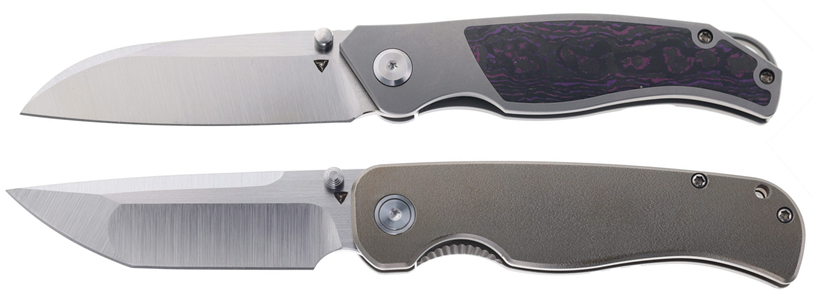
Per the company’s marketing materials, TuyaKnife focuses on making high-end, high-quality knives, using premium materials and skilled machining to make their knives not only beautiful, but durable. They manufacture their own knives themselves, as well as doing OEM work for others in their factory in Yangjiang, Guangdong, China. The whole TuyaKnife team, from the owner, Kevin, to Dave himself, are all avid knife enthusiasts, and that drives them to keep involved in online enthusiast groups where they openly seek feedback from other enthusiasts to support their company values of making continuous improvements to their products. Per Dave, all TuyaKnife knives have a lifetime warranty, demonstrating they stand behind their products, their craftsmanship and the materials they use. Dave himself offers the kind of customer service he’d want as a customer, focusing first and foremost on showing people respect and treating them the way he’d want to be treated. His work includes servicing customer warranty claims by replacing fasteners, pocket clips, and when needed, replacing the knife if a quality issue comes up. The TuyaKnife owners fully support Dave’s call on these matters, so customers are treated well.
Now, of course, many companies claim to make good stuff out of good stuff and well, are just good. Even when they don’t! I mean, how many companies intentionally make products of crappy quality, use crappy materials, and continue to use crappy designs forever? (Oh yeah, I almost forgot about Opinel). But in this case, I handled the TuyaKnife Anzu for quite a while (until I was forced to return it; it was a borrowed knife!), and I am suitably impressed. I’ll detail my impressions below.
One side note: in my internet searches to learn more about the company (before Dave helped me out!), I learned that a Tuya is a flat-topped, steep-sided volcano formed when lava erupts through a thick glacier or ice sheet. I’m not really sure how this is even remotely connected to a pocketknife manufacturer, but there it is.
Introducing the TuyaKnife Anzu
So what is Anzu, anyway? Well, it could be a number of things. For example:
- Anzu is a genus of theropod dinosaur (dubbed the “Chicken from Hell”) that lived in the central region of the North American continent that today is the home of US states North Dakota, South Dakota, and Montana. The Anzu lived during the Late Cretaceous period (between 100 to 66 million years ago, when the Chicxulub impactor was a buzzkill that spoiled the dinosaurs’ party). The species is officially called Anzu wyliei, which hitherto had been nameless until finally getting its long-overdue appellation in 2014.
- Anzu is a Japanese given name for females that literally means “apricot”.
- Anzu Robotics is a Texas-based company that makes drones, including the Raptor, which is similar to DJI’s Mavic 3 Enterprise.
- Anzu is an in-game advertising solution that works with PC and console developers to place ads that complement gameplay.
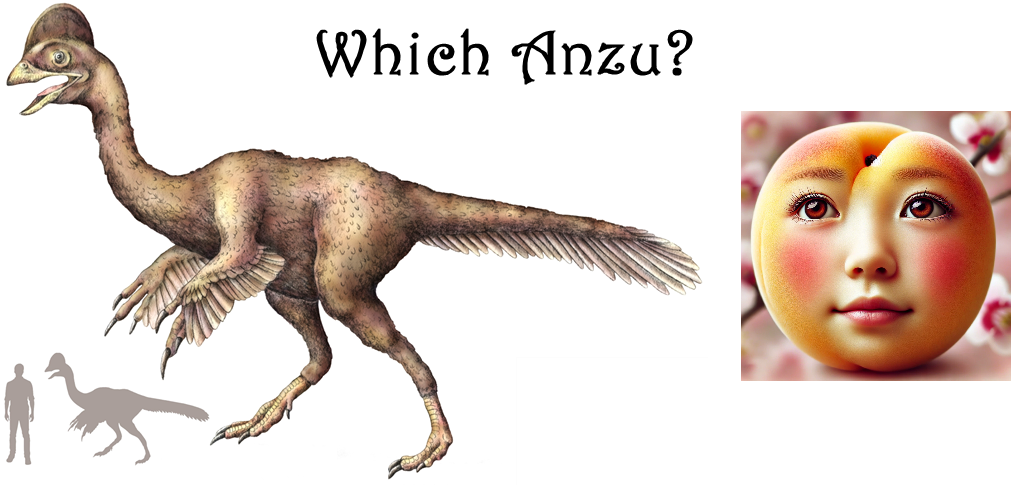
But most likely, TuyaKnife named their knife after Anzû, the enormous, divine storm-bird demon monster, a beast that breathes fire and water, originated from the Mesopotamian region some 4,500 years ago. In ancient Sumerian, Akkadian and other Mesopotamian religions, Anzû was at the time depicted as either a massive bird that is half man and half bird, although Anzû is alternately depicted as a lion-headed eagle, sort of the opposite of the mythological Greek griffin. Anzû is the personification of the southern wind and thunder clouds, and appears in the Sumerian epic poem Gilgamesh, Enkidu, and the Netherworld.

Interestingly, Anzu the dinosaur was named after Anzû, the gigantic, Mesopotamian monster bird. Of course, it could have been named after a small, tart drupe, so I guess things worked out okay.
So this is a flat-topped, steep volcano that erupts under glacier ice company that makes a huge, monstrous demon bird of wind and thunder that looks quite like a griffin knife. Well, I have to say, I just don’t see the resemblance.
The TuyaKnife Anzu knife (yes, this time I’m referring to the actual knife) was introduced in late December 2024 to much acclaim. Its carbon fiber scale inlays are available in 3 colors: Blue Marble, Red Marble, and Black Marble, all of which look almost exactly the same (at least in the photos I’ve seen online; the color hues are barely a suggestion within the CF marbling). I’ll be reviewing the Black Marble Anzu in this article (or is it a different color? It’s kinda hard to tell!).
This is my personal introduction to TuyaKnife products, so let The Knife Karen review begin.
Details and Specs
The Anzu is a stylish, well-made folding knife that is built with excellent materials. It has solid specs, uses top-quality materials, the action is an absolute joy to use, and it’s a handsome looker as well. I’ll say it’s sharp all around (I’ll explain what that means as we go on).
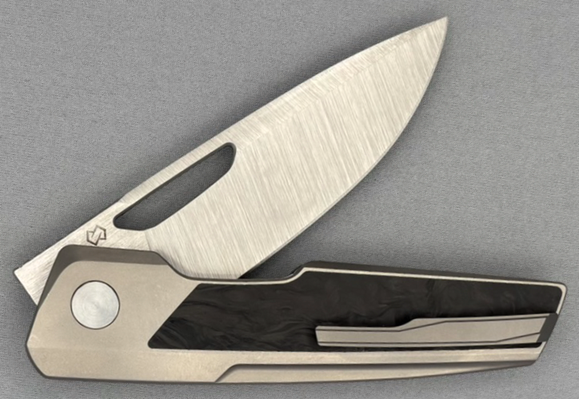
Blade
TuyaKnife uses the venerable Bohler M390 for the Anzu blade. TuyaKnife apparently makes the best use of the capabilities in M390.
Blade Details
The Anzu is equipped with a robust, visually appealing drop point-shaped, saber-ground blade that hosts 2 grind regions: the large, primary bevel, and above that, a long swedge that runs the full length of the blade, separated with a handsomely done, sharply precise grind line between the regions. It’s a very attractive blade shape.
Finish
That said, the blade finish is rather unusual. In fact, it’s really quite odd. The blade looks to have a sort of machine-satin finish, but a finish done on an extremely coarse grit grinder! The blade literally has bold, vertical striations across the steel that are so rough-hewn that it looks unfinished, while simultaneously looking highly finished. That by itself is a very interesting design choice. These striations are not on the spine, but that’s the only exception. They cross through the swedge, the primary bevel, and even the blade edge.

I realize that some folks are very keen to have low-grit, vertical scratches on the edge bevel, giving the blade a micro-sawtooth-like cutting edge to help the knife cut aggressively. Such an edge finish is akin to the difference between a plain-edge chef’s knife and a serrated bread knife. If one needs to cut a crusty loaf of warm bread or a fresh tomato, using a serrated-edge knife to cut in a sawing motion through these will yield excellent results. The blade serrations easily catch the surface to be cut, which helps the cut go quickly and cleanly. However, if you want to smoothly shave some delicious slices of prosciutto (or for the guys out there, shave your stubbly face!), I need not tell you that a serrated blade is not the way to go! You want a finely honed, razor-sharp, smooth edge that can push and/or pull cut, not just saw, through the material (be it salt-cured meat or facial hair, although not the meat on your hairy face!). For the folks who like blades with micro-serrated edge bevels, then the blade finish of the Anzu will make you very happy.
Of course, we’re not only talking about a micro-serrated edge bevel. We’re actually talking about what amounts to serrations on the blade face, except those serrations aren’t sharp and are not meant for cutting. If anything, when you are using the blade to cut thick cardboard or something analogous, vertical striations on the blade surface like those found on the TuyaKnife Anzu will actually make the cutting effort more difficult, as those ridges are an impediment to smooth cutting, will abrade against the sides of the material being cut and generate resistance. For me, if this wasn’t a borrowed knife, I’d have popped it onto my fixed angle sharpener, then hit it with several passes on multiple grits of Venev Orion stones, then several more passes on a good leather strop to put a great, smooth-polished edge on it! However, I’d still be left with that gnarly, striated blade face finish. Hmmm. Let’s just say I’m not really a fan of that textured look (and feel) on the face of the blade steel. I’m more of a smooth and sexy, polished finish gal.
Jimping
There is some jimping on the blade. In fact, all 3 non-blade sides of the tang area are jimped. There is a 6-cut jimp on the side of blade tang that, when open, supports your thumb on the spine. Along the front flipper of the closed knife, the top side has 4-cut jimping, while the opening hole side, where you perform the front flip, sports 5-cut jimping. All blade jimping on the Anzu is coarsely spaced with flat-topped cuts, leaving the edges of the jimping reasonably sharp (but not uncomfortably sharp, unless you flip it open 100 times in a row!), which provides very grippy, effective ridges.

Markings
Unlike most knifemakers, TuyaKnife designs their knives to be practically free of blade markings. On the Anzu, there are only 2 small logos. On the show side, there is a small TuyaKnife logo on the ricasso up close to the spine. Regarding the clip side, there is a small Matsey logo in the same upper position on the ricasso. In a really nice design touch, neither logo can be seen when the blade is fully open. They both go into hiding behind the front top of the handle scales! I love that!
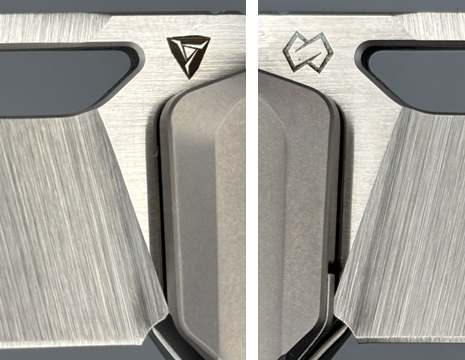
Choil
One more thing to celebrate about the blade is that it has a good sharpening choil (something Spyderco and Opinel ignore with their blades). As I am someone who does her own knife sharpening, I appreciate a Goldilocks sharpening choil. Not too big (then it’s a finger choil), not too small to be useful (or just omitted, right Mr. Glesser?), just right for sharpening while preserving as much cutting edge as possible. Well done, boys!
Sharpness
The out-of-the box blade sharpness is quite good. It slices paper without any hesitation. I was plenty satisfied with the knife’s initial cutting ability. I do wish I had one of those BESS-certified blade sharpness testers, as slicing paper is hardly a reliable, objective way to make an assessment of sharpness. So much of this subjective determination depends on the angle of the blade to the paper, the thickness of the paper, whether the tester pushed or drew the knife against the paper, and more. But I don’t (not yet), so this is what you get (for now).
Ergonomics
However, I do have some constructive criticism of the blade on a couple of issues that are more important than the striated aesthetic of the blade surface. Let’s talk about edge sharpness (and I don’t mean the blade edge). The opening hole, a feature so generous with its size and accessibility, is actually rather sharp along the perimeter of the hole. If you look at it or feel it with your fingertip, it doesn’t seem that bad. But to do a reverse flick, you need to use the front surface of your middle finger’s nail. I can tell you that every time I make that satisfying reverse flick that is so much fun to do, a little bit of my Knife Karen’s fingernail is scraped away. The perimeter of the opening hole has an edge cut to dull what would otherwise be a wicked 90° edge, but just making a basic edge cut it still leaves an edge sharp enough to scrape away your nails. Making it totally rounded isn’t the answer, but a little bit of chamfering of the resulting cut edges would be greatly appreciated. While this borrowed knife is in my possession, my delicate Knife Karen fingernails will not be wearing polish (we’ll see if that changes once I give it back!).

But as sharp as the opening hole edges are, the nasty blade spine edge makes the opening hole feel velvety smooth. There is absolutely no chamfering along that blade spine. I’m guessing that crowning was out of the question? I imagine that the designers thought, “we have a spine-length swedge all the down, which makes the edge angle less than 90°. That’s good enough.” Well, being the big nerd that I am, I calculated the swedge angle to be ~22°, which means the spine angle is ~112°. Now 112° is larger than 90°, right? And the atrocity of unchamfered, 90° blade spine edges are reserved for knifemakers like Spyderco (and as I’ve learned, Opinel). But an unchamfered 112° blade spine edge is to me, well, an unfinished knife blade. To my friends at TuyaKnife – please finish the edge work on your blades. Think about the children! Or at least the preciously soft Knife Karen finger skin!

Not to be just a total complaining crank, as I alluded to earlier, the shape of the blade is graceful, elegant, and quite stylish. When open, that vaunted swedge/primary bevel grind line is perfectly aligned with a corresponding angled line spanning the length of the blade handle. It’s a visually captivating design. The style of this drop point’s presentation is simultaneously beefy and elegant. I like very much how it looks, other than the vertical blade finish that looks like it was done with a wire brush wheel (maybe it was!).

M390 TECHE
When I can get the ratings data for the knife steels I review (I primarily gather the data from the authoritative KnifeSteelNerds.com as available), I include it here in a section I call TECHE. What does that mean? Well, just look below.
Note that all but Hardness Range are based on a scale from 0-10; Hardness is based on the Hardness Rockwell C scale, which technically is between 20 and 68.
| Color Key: | Poor | Mediocre | Good |
|---|

* HRc Hardness Rating data was gathered from the White Mountain Knives, the only source for this data I found.
** Ease of Sharpening data is not a rating produced on KSN.
Blade Dimensions
Let’s talk numbers. The Anzu blade length was measured at 89.84 mm / 3.54″ and the cutting-edge length is 87.54 mm / 3.45″. The blade height came in at 28.84 mm / 1.13″ and its thickness is 3.18 mm / 0.125″. The primary bevel angle was recorded at 8°, whereas the ole laser goniometer noted the original edge angle at 21°. Also, the main bevel edge thickness was measured at 0.48 mm / 0.019″. Lastly, the blade’s sharpening choil was 6.87 mm / 0.271″ across, not big enough to sacrifice cutting edge length, but not so small that you can’t properly sharpen the blade. The choil is very well executed.
HRc Rating
The Anzu webpage on TuyaKnifeUS.com states their M390 blade is rated between 60-62 HRc (or as they define it, 61 HRc +/- 1 HRc). The only online retailer I could find for the TuyaKnife Anzu, WhiteMountainKnives.com, puts it firmly at 62 HRc.
If the rating is in fact 60-62, given this is not a coated blade, it’s likely on the higher side of the spread, which would be great news for us, the potential customers of the TuyaKnife Anzu. So many other knifemakers seem to believe that the mediocrity of 59-61 for M390 is acceptable, claiming this to be their self-defined “industry standard”. Sure, the potential for 61 from those knifemakers would be nice, if it gets there, but seeing something closer to 59 is more likely (because proper heat treatments take time, and thus are expensive, and this is where corners are often cut). Many people believe that the HRc ratings of coated blades are 1 HRc point lower due to the process of applying those coatings, although that depends on the type of coating applied. All these reasons reduce the potential hardness of the blade steels we buy, which is very disappointing. So is 62 wishful thinking? Technically correct? I can’t say, as my crappy little hardness tester crapped out on me (the results were crappily low on my own crappy knives, and it won’t any longer calibrate or produce expected hardness ratings on my crappy certified steel test disc). But 62 HRc? For M390? Call me impressed. However, given that M390 is already rated fairly poor in toughness, be cognizant that at that high hardness, it may be rather chippy and brittle, you know, like a sharpened Dorito.
Opening Mechanisms
The Anzu offers 2 methods of opening the blade:
- A coarsely-jimped front flipper
- A long, isosceles trapezoidal opening hole for fun reverse flicking
Both methods require that you must overcome a near perfect level of detent, making the process very satisfying. I’ll have more detail on that detent coming up in a moment.

Let’s talk about these blade opening methods. Now I’m typically not a fan of front flippers. I find them to be harder-than-necessary to use, especially when in a moment of crisis and you need that blade to open lightning fast! To me, front flippers are just not as intuitive to use compared to thumb studs, or a flipper tab, or even an opening hole. Basically, everything else out there. I initially found this to be the case when I first got the Anzu, but only for a little bit. Once I figured out how to use my fingertips to press the clip side of the handle into my right hand’s thenar eminence (aka the meat of my thumb), then placed the radial side of my thumb against the top edge of the front flipper’s jimping, and then executed a firm, quick thumb flip, it was a breeze. Due to that aforementioned excellent detent, the heft of both the blade and the handle, that firm thumb flip literally blasts the blade through that detent, rockets up past the pivot, and slams home against the opening stop pins, engaging the beefy liner lock with an extremely satisfying BAM! So, yeah, thanks to the Anzu, I think I like front flippers now – or at least the one on this TuyaKnife.
Next up is the opening hole. The hole is actually a long, trapezoidal slot (which means it’s spacious), the handle cut-outs for the opening hole are generous, and it just begs for a middle-finger, reverse flick. And thanks to the excellent action on this knife, the reverse flick is easy to do and is equally as satisfying as the front flipper for opening the blade with a BAM!
So let’s finally talk about the excellent action here. The detent of the Anzu is glorious. The detent ball on the liner is placed very close to the liner’s top edge. This means that when the liner lock is disengaged, the detent ball is automatically cleared because of your thumb’s momentary hold time spent depressing the liner. And this is when the engineering of the pivot and its bearings comes into play. Once the liner is released, the blade drops softly and slowly, responding exquisitely to tiny, encouraging shakes to close the blade. Of course, if you just hold the liner release open, the blade will drop quickly, like any other liner/frame lock knife. The beauty here is that when it is closed normally, it won’t drop onto your thumb like a guillotine! The action here is as smooth and buttery as a well-worn-in set of phosphor-bronze washers, but the Anzu runs on caged bearings.
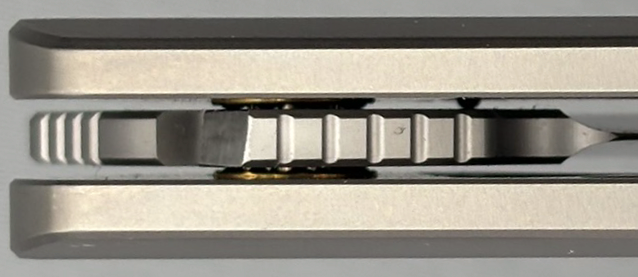
Then when the blade has dropped down to the point of being almost closed, the height of the detent takeover, where the blade tip hovers just above the handle before the detent ball smoothly slips into its closed resting divot and finishes closing the knife, is a mere 5.65 mm/0.223” (7/32”). Of course, the blade will drop closed with no special need on the user’s part to press the blade down into place; I‘m just commenting on how lovely the detent works. This silky action is the most beautifully engineered feature of the Anzu.

Locking Mechanism
The TuyaKnife Anzu employs a liner lock. But that’s really an understatement. The Anzu uses a long, all-steel insert bar attached to the inside rear of the clip side titanium scale (not just a fastened-on, liner lock insert tip), ensuring a reliable, steel-on-steel lock-up on the blade tang. OK, so what’s new here? For one, the liner is a robust 1.45 mm / 0.057” thick strip of steel. Secondly, it slides into place on the tang with authority, covering around 45% or so of the blade’s tang width. Does that make you worried about lock stick? If you read my post comparing the cheap pocketknives sold at Harbor Freight, the $10 Gordon knife there also uses a liner lock, but it was atrociously bad. When opened and its skinny 1.11 mm / 0.044” lock bar is engaged, that bar slips onto the 2.81 mm / 0.111” tang by perhaps as deep as 60% (meaning there is tang revealed on the lock side once that spindly lock bar slips into place). Good and secure? Yeah, kinda, but only because the lock stick on this knife was terrible. Is a liner lock secure when you can’t release it? Maybe? Does this mean that deep engagement of the lock bar onto the tang means it’ll be difficult to release? Not necessarily. Is a $10 liner lock knife a reasonable comparison? No, but it was a topic I had recently written about, so it was on my mind. So there it is.
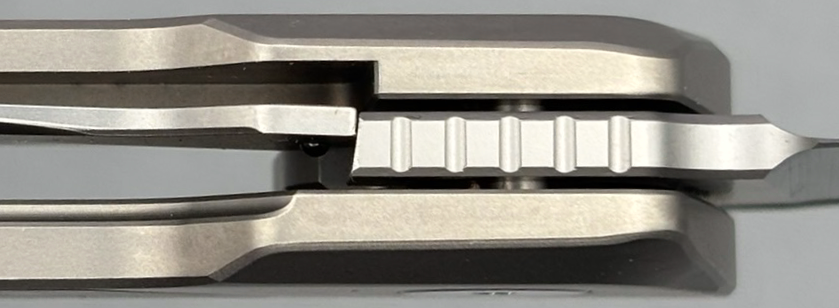
In fact, the deep-seated, chonky liner of the Anzu releases with ease, not because it’s loose, but because the machining tolerances of the Anzu’s steel liner bar are precisely done. This is the type of quality you get when you buy a higher-quality knife with excellent engineering versus a low-quality, piece of crap doohickey made from rando parts thrown together.
The Anzu has zero lock stick, no lock rock, no open knife blade play, nor any detent lash. If you are a sensitive little flower who can feel a mushy pea buried under a dozen memory foam mattresses (and I swear I’m not talking about me!), you might notice an infinitesimally small amount of pivot lash. Firmly holding the knife in the half-open position and pulling the blade up and down, there is a tiny amount of movement. Compared to the crappy Harbor Freight Gordon knife, which has so much pivot lash wiggle that the test actually makes audible sounds(!), the Anzu was really minimal. However, for comparison, the Civivi Vision FG in my pocket exhibits ZERO pivot lash, a knife that costs 1/3 the price.
So is this really a problem with the Anzu? Nah, likely not. It really doesn’t amount to much of anything. So why then even mention it? It’s a fair evaluation factor that I’ve been doing in my reviews. Identifying a characteristic like this, in some cases, may potentially identify manufacturing quality concerns compared to other knives that do not exhibit this. But let’s put this in perspective: a microscopic amount of blade-pivot wiggle with a hard pull and push won’t make a functional difference. But since it’s fair to evaluate a knife on all performance factors, not only the factors that make the knife look good, and since many knives have no pivot lash, it is what it is. Maybe the person from whom I am borrowing this knife got a slightly less-than-perfect version. Whatever. Let’s move on.
Knife Body & Scales
The Anzu handle possesses a pair of hefty chunks of titanium. The polished gray titanium scales, already very nice in their own right, sport beautifully-done, perfectly fitted, black marbled carbon fiber inlays – on both sides! In addition, the titanium scales feature both concave and convex design lines running down the handle body, including a convex line that, when open, runs from blade tip to handle butt, consisting of the swedge/primary bevel grind line and the line above the handle’s CF inlays. Then the concave section that runs along ~2/3 of the handle length correlates to the top of the blade’s trapezoidal opening hole. And the pocket clip on the right side not only has its own concave grind lines, on the bottom of the clip is a grind feature that mirrors the liner lock access cutout on the handle scale. Lastly, but not leastly (is that a word?), there are no visible fasteners anywhere on the Anzu, giving it quite a clean, sleek look. You almost don’t notice that you don’t notice it until you notice it! And once noticed, it sure is noticeable!

However, the scales and the CF inlays are so smooth and polished that there is a genuine risk of the knife becoming too slick when your hands are wet. Applying a gorilla grip on the handle, specifically in the area of the liner lock access cutouts, can add a modicum of support. But to the point: keep your hands dry, baby!
The scales do not have, nor do they need, steel liners. The thick titanium scales provide all the structural support needed for the knife, including support for the steel insert lock bar. Both of the scales are significantly milled for weight reduction. Even so, the balance point on the knife is about 7/8” down the handle, making the knife fairly butt heavy. However, 7/8” behind the center of the pivot puts the balance point up against the front edge of the liner lock cutout, so it seems even that big booty was accounted for.

The knife has a pair of stop pins located to the lower left of the pivot from the show side view. I can see the pair of pins there, and they do not move as the blade does, so they must run in a groove along the blade tang (note that as this is a borrowed knife, I will not take the liberty of disassembling the knife to confirm this presumption about the stop pins). As there are no other stop pins in the knife, I presume these serve as both opening and closing stop pins.
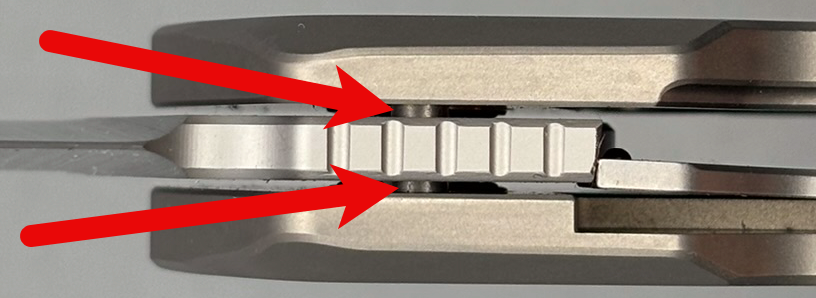
The Anzu uses a captive, stainless-steel pivot in the form of a plain, round, flat puck that sits flush with the Ti scales and comes equipped with a T8 socket. A pair of caged bearings support the action of the pivot, although the action itself is buttery smooth like a set of phosphor-bronze washers rather than the typical glassy slick slide of bearings – it’s a great feel! That pivot provides perfect blade centering within the handle. One odd detail, though. TuyaKnife presented the socket side of the pivot on the show side of the knife. It’s like they made a mistake during assembly and installed the pivot backwards! Or perhaps this is a Matsey-kind of design-y thing. Call me old-fashioned, but I do prefer the clean side of the pivot on the show side; after all, that’s what “show” side means.
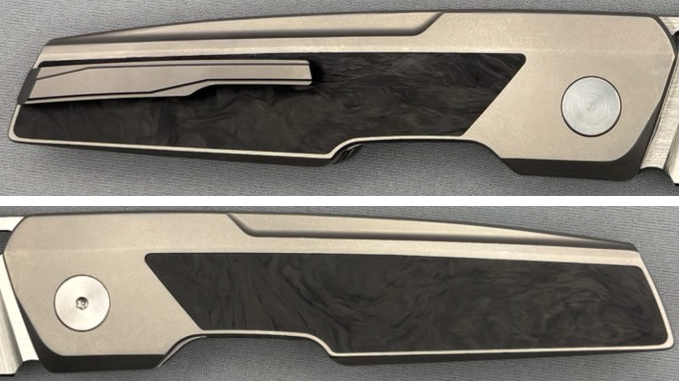
The Anzu does have a backspacer, although it’s an unusually dinky, little thing! We’ll call it micro-pinky backspaces syndrome. The shortie spacer only spans 27.89 mm / 1.10″, leaving 55.83 mm / 2.2” of open space between the spacer and the blade tang then the knife is open.

And one more note – the regular boys, Jordan, Kent, and Owen, the last 3 dudes who care about lanyards, won’t be happy with the Anzu. There’s no place at all to attach their paracord snake knots! Boo hoo!
Overall, I call the Anzu a clever, thoughtful and appealing knife design, but who’s surprised by that? After all, the designer of the TuyaKnife Anzu is the enigmatic Maciej Modrzejewski (aka The Matsey), a cool, modern, designer from Poland who is known for his use of high-end materials incorporated into angular, geometric themes in his knife and EDC products. His fingerprints are all over this knife (metaphorically speaking, although I did have the wipe off some smudges when I got this knife), and that seems to be a significant contributing factor as to why this is a very good knife.
Handle Dimensions
We have more numbers to cover. The length of the TuyaKnife’s Ti and CF handle is a solid 115.61 mm / 4.56″, giving the knife a blade-to-handle ratio of 0.78. The handle’s thickness is a moderate 13.55 mm / 0.53″, while the closed handle height was measured at 31.49 mm / 1.24″. The thickness of the titanium scales came in at 3.71 mm / 0.15″ and that tiny backspacer was measured at a micro-pinky length of 27.89 mm / 1.10″. Lastly, I calculated (roughly) the amount of liner lock-up onto the open blade tang to be ~44%, give or take a few microns here or there.
Hardware
As noted earlier, there’s not a whole lot to say about the hardware on the Anzu. By appearances sake, there isn’t any! Well, technically there has to be, but there are no visible fasteners whatsoever (aside from the T8-socketed, show-side pivot)! But we can still talk a bit about the pocket clip. As mentioned earlier, the milled titanium clip’s shape is a reflection of the scale’s shape where the cutout for the liner lock access is located. The clip also hosts sculpted lines that are almost reminiscent of the way the CF inlays are applied to the scales. Almost. The clip makes contact with the scale onto the carbon fiber inlay with a V-shaped ramp toe. There is no specific “bald spot” on the handle as the CF inlays are already super-smooth (if not to a fault). The clip is only available in a tip-up, right-handed only configuration (TuyaKnife is sorry, lefties!). The clip length measures in at 51.57 mm / 2.03″, which puts the clip length to handle length percentage at 44.6%. And we’ve already mentioned that there are clip fasteners visible on the Anzu, giving it quite a clean, sleek look.
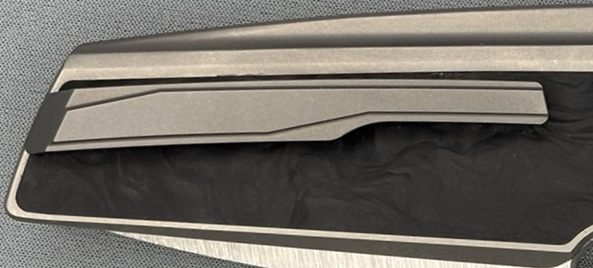

Ergonomics
The Anzu is a comfortable knife to hold. It’s not amazing – it would need some contouring to get there, but that would break the angular aesthetic that Matsey likes to do. Still, regarding the handle, there is a good amount of chamfering, of softening edges (just a bit) on the edges of the scales inside the blade channel. There’s many of these nice, little details on the handle, which is why I am so surprised at the complete lack of any chamfering along the blade spine. So weird. So contrasty.
And speaking of the ergos on the blade, as (also) mentioned earlier, when using the opening hole to do a reverse flick (which is a lot of fun to do on this knife), the edges of the opening hole are also quite sharp. They appear to have been knocked down with some sort of cut, but nothing else, so there is still residual, angular sharpness. The result of that is you scrape off a little bit of the middle finger’s nail with each flick. This feature could have been done better. But I will have to say that both the function of the opening hole and the front flipper, due to the brilliant detent on the Anzu, makes this knife open with a powerful BAM! It’s almost worth scraping away your fingernails to enjoy the opening action of this knife!
Weight
The TuyaKnife Anzu is a beefy little dude. It’s not quite a full-size knife as the open knife only measures a moderate 199.43 mm / 7.85″ in length, just a smidge short of the unofficially official minimum length of 203.2 mm / 8” to be considered a full-size knife. So given the weight of this little beefcake, 116.24 g / 4.10 oz., the weight-to-blade-length ratio comes in at 1.29. Hey, The Knife Karen likes me a little beefcake every now and then!
Original Packaging
The TuyaKnife packaging is OK. Nothing too special, but then again, I’m of the mind that I’d rather have them not charge me more in the price of the knife just to pay for their costs for packaging I will put aside and likely never use again (unless I might one day resell the knife). That said, there is one interesting feature that isn’t common among the huge folding knife market out there. TuyaKnife includes a softened, folding leather slip with the knife. That’s usually a feature with pocket-clip-free knives and slip joints. But TuyaKnife decided to add this extra feature (but I do wonder how much it raised the price of the knife). The slip is made of medium-brown, super-soft, saddle-stitched leather with a top folding tab that encloses the knife and tucks into a stitched leather half-loop in the front. I guess it’s nice, but if it had been an add-on accessory for a separate price, I would not have ordered it.
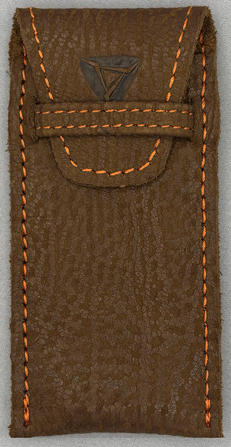
One cool thing about the slip, though, is that TuyaKnife did some leather stamping work on the reverse side of the flap to include this little message to you, their customer (assuming you did buy the thing): “Thank you for adding a TuyaKnife to your collection!” I thought that was a nice touch, even if I had to involuntarily pay for the leather slip.

The packaging consists of a heavy, rigid, attractive metallic blue paperboard, full telescope box with a dense, very firm, very fine, open-cell foam lining pressed into the lower.
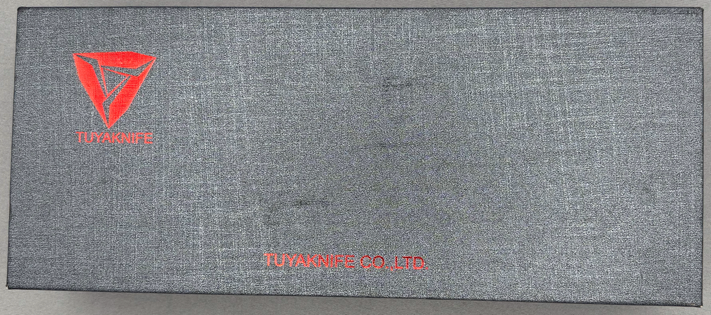

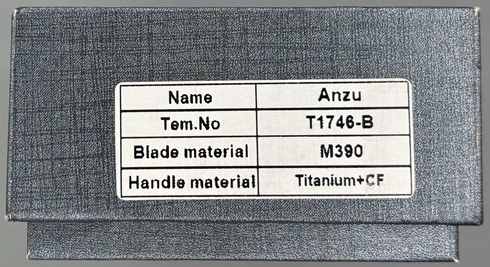
In addition to the knife is the aforementioned leather slip, a large, 2-color printed cardstock that includes the TuyaKnife contact information as well as a message thanking the user for purchasing a TuyaKnife. You kinda get the warm fuzzies with these guys! Lastly, you know your knife and the leather slip are fresh because they come sealed in a plastic wrapper, similar to a Food Saver vacuum bag.
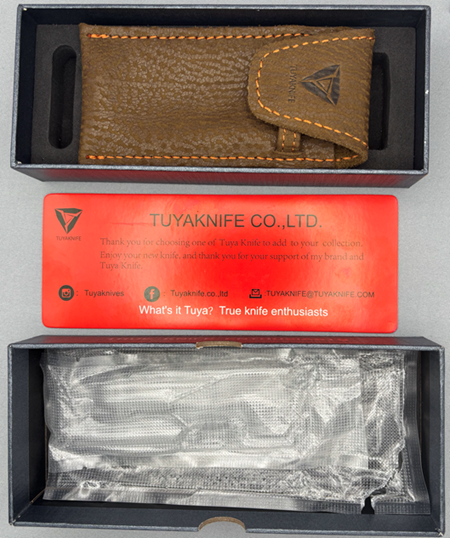
Knife Karen Nitpicks
This was my first exposure to a TuyaKnife product, and I was pretty impressed. Yeah, I liked it. Although there were just a couple of little things. A few little complaints that, well, do add up. Little annoyances that bothered me. Sort of got under my skin. Got stuck in my craw! Boy, these elevated my hypertension. They really boiled my blood! I must speak to the manager! Right now! Hello? Does anybody work here?
- The striated blade face finish looks like it was done on a bench grinder using a wire wheel made of tungsten bristles. Thick tungsten bristles. Or maybe a 10-grit sanding belt.
- The blade spine edge is nearly as sharp as the lovely edge bevel. Hey, my friends at TuyaKnife! You only need to have one side of the blade be sharp! I have a request: Please check out that renowned, Italian knife feature called a crowned edge. It’s very nice, actually!
- The blade pivot was installed backwards! The clean pivot face is on the clip side and the T8 socket face is on the show side. What’s up with that?
- I don’t like knives with front flippers. They are hard to use! They usually make it difficult to open the blade. Well, technically, it worked pretty well on the Anzu. Once I figured out how to hold the knife, the front flipper was kind of fun. It really blasted through that amazing detent! HEY? What’s happening to me???
- The titanium and carbon fiber-inlay handle is smooth. Very Smooth, in fact. While it feels good most of the time, if your hands get wet, it might be slippery! (Sheesh, that’s about as stupid as those people who complain that Winterblade knives, which often use magnets in the action, will attract metal shavings!). HOT TIP, folks: Keep your hands dry and don’t allow your knife to hang out in steel milling shops!
- The knife is fairly butt-heavy, but that’s because TuyaKnife opted to not use a ridiculously think blade (looking at you, Medford). They could have instead opted to make the titanium slabs on the handle thinner, but, well, I like titanium, so I’ll just keep my big booty knife and keep my hands even dryer.
- There was a tiny bit of pivot lash in the Anzu. What is pivot lash? It’s a bit of looseness at the pivot when the blade is half open and you check for up and down movement, indicating potentially milling tolerance imprecision. It’s not Ozark Trail loose – absolutely not! But there was a tiny bit of movement in the Anzu. However, in comparison, there is no pivot lash in my Civivi Vision FG. And for what it’s worth, I am borrowing a WE Solid at the moment, and it’s ~2x the cost of the Anzu, and it also has a tiny amount of pivot lash. So whatever.
- So what is the Anzu named after? The dinosaur? The Japanese apricot girl? Or maybe the Mesopotamian Mega Monster bird? I’ve got to know! This mystery is driving me batty!
Price
The MSRP from the US TuyaKnife site was $269, but at the time of this writing, it’s now $249. The only online retailer I could find that sells the Anzu, White Mountain Knives, is sold out, but also lists the Anzu at $249.
Verdict
I found the TuyaKnife Anzu to be a very good knife. I enjoyed my time with it as I wrote this review (unfortunately, I had to borrow the knife to write this article, so it wasn’t mine to keep). Let me tell you why I liked it.
First off, the best feature of the Anzu is the blade action is fantastic, as is the well-engineered detent. The blade will open with a sharp blast past that beautifully engineered detent, slamming into place with a confidence-inspiring BAM. The knife offers either a large, trapezoidal opening hole or an effectively jimped front flipper, and both work very well powering through that detent. Once opened, a hefty, all-steel liner lock bar slips in quite deeply behind the blade tang. When I was ready to close the blade, the handle’s generously cut liner lock cutouts gave me easy access to that thick lock bar. Just a gentle compression of that firm, sprung lock bar smoothly moved the liner off of the tang – no lock stick at all. The engineering of the liner lock bar detent enabled the blade to quickly pass the detent ball, and then begin its slow, buttery smooth descent toward the handle’s blade channel home. No guillotine here! And this knife’s pivot runs on caged bearings, not washers! The opening and closing blade action around that sweet detent is a thing of beauty.
The handle of the Anzu is based around 2 nice slabs of polished titanium. These Ti scales feature a pair of perfectly fit, inset carbon fiber inlays – 1 on each side! The handle is well chamfered and sculpted with the expected angular, geometric design of The Matsey. The nicest features of the design are how the lines come together. When the blade is fully opened, the convex handle line just above the inlay is an extension of the crisply defined convex line on the blade that delineates the swedge from the primary bevel. And to add on to matching lines, the edge line of the concave section above the full-length knife line at the middle back of the handle corresponds to the top line of the opening hole.
To complement the sleek design elements of the handle are the complete absence of any visible fasteners. It’s not only beautifully engineered, it’s visually beautiful as well.
Next, we have the blade. I just love the incredibly taut, pronounced grind line between the full-length swedge and the main bevel. I am also impressed by the fact that the blade is heat treated to a hardness of between 60-62 HRc (although WhiteMountainKnives straight up calls it 62 HRc). That’s truly remarkable for M390. Although it does make me wonder how the low toughness of the already brittle M390 will handle that level of engineered hardness.
But there are some disappointments for me in the blade half of the Anzu. First off, the blade finish is a deeply striated series of vertical scratches that makes me think the blade was finished on either a bench grinder using a tungsten bristle wire wheel or a 10-grit belt sander. Despite appearing to be profoundly unfinished, the clarity in the application of the blade face striations, starting at the swedge, then crossing straight down through the main bevel, and continuing through the edge bevel, clearly identifies this as a precisely applied blade finish. It is definitely not my cup of tea (and in case you were wondering, my cup of tea is a hot serving of Golden Monkey tea).
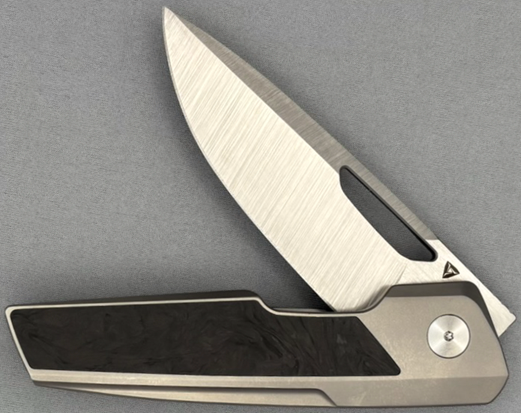
Continuing with the blade issues, the blade is sharp along several edges. The perimeter of the opening hole was sort of cut to reduce the 90° edge, but this wasn’t enough. While I love using the opening hole to open the blade with a reverse, middle-finger flick, doing so scrapes off a bit of the surface of that fingernail. While it should not be as rounded as the body of a candlestick telephone (weird reference, huh?), the cut edge currently left behind is not finished as it should be.
And speaking of not finished, let’s talk about the blade spine. While it’s not the 90° abomination that comes on Spyderco and Opinel knives, the Anzu spine edge is slightly improved by the fact that the swedge angle makes the spine edge angle ~112°. But that is a purely unchamfered, untouched 112° of knifey sharpness, which makes the opening hole feel as soft and gentle as a velvet rope. This is an ergonomic disappointment for me.
Lastly, we’ll go back to the handle for one last nitpick. The blade pivot was installed backward! The clip side has the smooth, plain, circular steel inset pivot. On the clip side. The show side showed the pivot with the T8 socket. That’s backward, folks, but given the high design features applied elsewhere in this knife, I have to believe this was done on purpose, perhaps in an ironic sense of rebellion against the machine. The milling machine, to be exact.
To be sure, overall I really liked the TuyaKnife Anzu. For the $250 knife, it has a ton of excellent design and material features that make it a standout. The fact that it isn’t perfect makes this a typical example of human-made objects. I have yet to see a perfect knife, but that doesn’t mean “imperfect” is undesirable. I personally like the blade shape of the TuyaKnife Envy v4 even more, and it appears that it might have a less-heavy striated blade finish, which would be lovely. Maybe I’ll get a chance to review that later this year! Enjoy! ![]()

